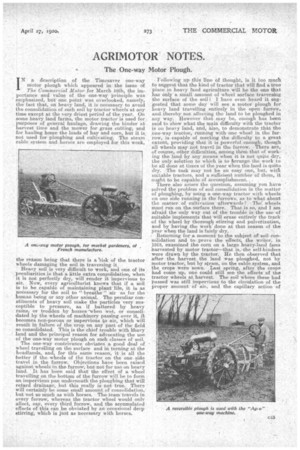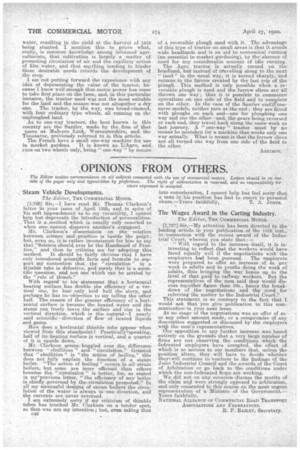AGRIMOTOR NOTES.
Page 25

Page 26

If you've noticed an error in this article please click here to report it so we can fix it.
The One-way Motor Plough.
IN a description of the Timesaver one-way motor plough which appeared in the issue of . The Commercial Motor. for March lath, the importance and value of the one-way principle was emphasized, but one point was craerlooked, nainely, the fact that, on heavy-land, it is necessary to avoid the consolidation of such soil by tractor wheels at any time except at the very driest period of the year. On some heavy land farms, the motor tractor is used for purposes of general haulage, drawing the binder at harvest time and the mower for grass cutting, and for hauling home the loads of hay and earn, but it is, not used for ploughing and cultivating. The steam cable system and herses are employed, for this work,
the reason being that there is a 'risk of the tractor wheels damagingthe soil in traversing it.
Heavy soil is very difficult to work, and one of its /peculiarities is that a, little extra consolidation, when it is not perfectly dry, will render it impervious to air. New, every agriculturist knows that if a soil is to . be capable of maintaining plant life, it is as necessary for the soil to " breathe" air as for the human being or any ether animal. Th& peculiar constituents of heavy soil make the particles very susceptible to pressure, as. if battered by heavy rains, or trodden by horses -when wet, or consolidated by the wheels of machinery passing over it, -it becomes non-porous or impervious to air, which will result in failure, of the crop_ on any part of the field so consolidated, This is the chief trouble with-Wavy land and the principal reason for advocating the use of the one-way motor plough on such classes; of soil. The one-way contrivance obviates a good deal of wheel travelling on the surfaee and in turning at the headlands, and, for this same reason, it is all the better if the wheels of the tractor on the one side travel in the furrow. Objections have been raised. against wheels in the furrow, but not for use an heavy land. It has been said that the effect of a wheel travelling on the bottom of the furrow will be. to form au impervious pan underneath the ploughing that will retard drainage, but this really is not true. There, will certainly be some small amount Of consolidation, but not so much as with horses. The team-traveIs in every furrow, whereas the tractor wheel would only affect say, every third furrow, and the accumulated effects of this can be obviated by an occasional deep stirring, which is just as necessary with horses. Following up this line of thought, is it too much to suggest that the kind of tractor that will find a true place in heavy rand agriculture will be the one that has cinly a small amount of wheel sat-face traversing the surface. of the soil? I have even heard it suggested that some day will .see a motor plough for heavy land travelling entirely in the open furrow, and.thereby not affecting the. land to be ploughed in any way. However that may be, enough has been said to show what the main difficulty with the tractor is on heavy land, and, also, to demonstrate that the One-way trader, running with one Wheel in the:furrow, is capable of meeting the difficulty to a great extent, providing that it is powerfulasnough, though all wheels may not travel in the furrow. . There are, of -course, other difficulties, among them that of working the land by any means when it is not quite dry, the only solution to which is to arrange the work to be all done at times of the year -When the land is quito dry. The task may not be an easy one, but, wita suitable tractors, and a sufficient number Of theta, it ought to be capable Of acComplishment. There also arises the question, assuming you have solved the problem or soil consolidation in the matter of.ploughing, by using a one-way tractor with wheels. on one side running in the furrows, as to what about the. matter, of cultivation afterwards ? The' wheels must run on the surface there. That is so, and I ant afraid the only was' out of the trouble is the use' of suitable implements that will erase entirely the track of the. wheel by thorough stirring and pulveaization, and by having the work done at that season of the year when the land is fairly dry.
Itetuaning for a moment to the subject of soil. consolidation and to prove the effects, the writer, in laaa, examined the corn an a. large heavy-land farm harvested by motor tractor—that is,-' the self-binders were daawn by the tractor. He then observed that after the harvest the land was ploughed, not by motor tractor, but by atearn, on the cable.system, and the crops were sown. Last spriag, after the crops had come up, one could still see the effects of the tractor wheels at harvest. The soil where. these had passed was still impervious; to the circulation of the proper amount of air, and the capillary action of water, resulting in the yield at the harvest of 1919 being stunted. I mention this to prove what, really, is conunon knowledge among informed agriculturists, that cultivation is largely a matter of promoting circulation of air and the capillary action of film water, and that anything tending to hinder these desirable needs retards the development of the crop.
I am not putting forwardethe experience with any idea of depreciating the value of the tractor, because -I know well enough that motor power has come to take first plane on the farm, end, in this particular instance, the tractor used was not the most suitable for the land and the season was not altogether a dry one. The tractor, by. the way, was broad-rimmed, with four ordinary type wheels, all running on the uuploughed land.
As to one-way tractors, the best known in this country are the Sander, made by the,firm of that name at MaVern 5.ink, Worcestershire, and the Timesaver, previously referred to hi this article.
The, French have a small one-way machine for use in market gardens. It is known as .I2Agro, and runs on two wheels only, being " one-way " by metals of a, reversible plough -used with it. The advantage of this type of tractor on.sm.all areas is that it avoids wide headlands and is an aid to economical running Kan essential in market gardening), by the absence of need for any considerable amount of idle running.
The Agri.) tractor is actually turned on the headland, but instead of tta,velling along to the next "
land" in the usual way, it is turned sharply, and returns in the furrow created by the last trip of the plough. This method is only possible when a reversible plough is used and the furrow slices-are all thrown one way ; thus it is possible to commence operations on one side of the field and to complete on the other. In the ease of the Sander andrezTimesaver models, neither turn at the end ; they are fitted with ploughs on each end—one for ploughing one way and one the other—and, the gears being reversed at each end, they travel back along the same work as last journey. A " one-way " tractor must by no means be mistaken for a machine that works only one way actually. What is meant is that the furrow slices are all turned one way from one side of the. field to the other.
AGRIMOT.




























